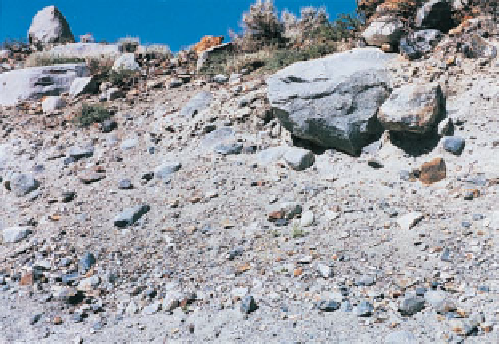Geology Reference
In-Depth Information
◗
Figure 14.15
End Moraine
End moraine
a
An end moraine deposited by a valley glacier. This particular end
moraine is also a terminal moraine because it is the one most distant
from the glacier's source.
b
Closeup of an end moraine. Notice that the deposit is not sorted
by particle size, and it shows no layering or stratifi cation.
Epoch, continental glaciers in the mid-continent region
extended as far south as southern Ohio, Indiana, and Illinois.
Their outermost end moraines, marking the greatest extent of
the glaciers, go by the special name
terminal moraine
(valley
glaciers also deposit terminal moraines). As the glaciers
retreated from the positions where their terminal moraines
were deposited, they temporarily stopped retreating numer-
ous times and deposited dozens of recessional moraines.
Lateral and Medial Moraines
Valley glaciers transport con-
siderable sediment along their margins, much of it abraded
and plucked from the valley walls, but a signifi cant amount
falls or slides onto the glacier's surface by mass wasting pro-
cesses. In any case, this sediment is transported and deposited
as long ridges of till called
lateral moraines
along the margin
of the glacier (
as
drumlins
(
Figure 14.17). Some drumlins are as large as
50 m high and 1 km long, but most are much smaller. From
the side, a drumlin looks like an inverted spoon, with the
steep end on the side from which the glacial ice advanced
and the gently sloping end pointing in the direction of ice
movement. Drumlins are rarely found as single, isolated hills;
instead, they occur in
drumlin fi elds
that contain hundreds or
thousands of drumlins. Drumlin fi elds are found in several
states and Ontario, Canada, but perhaps the fi nest example is
near Palmyra, New York.
According to one hypothesis, drumlins form when till
beneath a glacier is reshaped into streamlined hills as the ice
moves over it by plastic fl ow. Another hypothesis holds that
huge fl oods of glacial meltwater modify till into drumlins.
◗
Figure 14.16).
Where two lateral moraines merge, as when a tributary
glacier fl ows into a larger glacier, a
medial moraine
forms
(Figure 14.16b). A large glacier will often have several dark
stripes of sediment on its surface, each of which is a medial
moraine. One can determine how many tributaries a valley
glacier has by the number of its medial moraines.
◗
Stratifi ed drift is a type of glacial deposit that exhibits sorting
and layering, both indications that it was deposited by run-
ning water. Stratifi ed drift is deposited by streams discharging
from both valley and continental glaciers, but as you would
expect, it is more extensive in areas of continental glaciation.
Drumlins
In many areas where continental glaciers depos-
ited till, the till has been reshaped into elongated hills known
Outwash Plains and Valley Trains
Glaciers discharge melt-
water laden with sediment most of the time, except perhaps



Search WWH ::

Custom Search